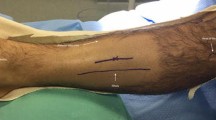Abstract
Increases in compartment pressure associated with chronic compartment syndrome (CCS) may be due to changes in the mechanical properties and/or thickness of fascia (4,22). To explore this possibility, we compared the mechanical and biochemical characteristics (stiffness, thickness, time-dependent response, collagen content, and collagen crosslinking) of fascia from patients with symptomatic anterior compartment syndrome to fascia from adjacent collateral compartments. We tested 43 specimens harvested from 20 individuals during surgical fasciectomy. Properties of normal (lateral)-compartment (NC) and pathological (anterior)-compartment (PC) fascia were mechanically tested in the axial and transverse directions forming four groups. An external control group (EX) of six specimens of anterior and lateral-compartment fascia harvested from amputated legs was also included in the study. PC fascia was found to be thicker and structurally stiffer (elastic modulus times thickness) in the axial direction than was NC fascia (p≤0.05). No significant differences were found between NC and PC time-dependent response, although significant differences between percent relaxation in the pooled axial and transverse direction specimens were observed. No differences were found in the collagen content, as measured by hydroxyproline (Hyp) concentration, between NC and PC fascia. PC fascia was found to have less collagen crosslinking by hydroxylyslpyridinoline (HP) concentration. In conclusion, although this study does not elucidate etiological factors in CCS, the changes found in PC fascia suggest that fascial mechanical properties contribute to the pathology.
Similar content being viewed by others
References
Bouché, R.T. Chronic compartment syndrome of the leg. J. Am. Podiatr. Med. Assoc. 80(12):633–648; 1990.
Brinkley-Parsons, D.; Glimcher, M.J.; Smith, R.J.; Albin, R.; Adams, J.P. Biochemical changes in the collagen of the palmar fascia in patients with Dupuytren's disease. J. Bone Joint. Surg. 63A(5):787–797; 1981.
Butler, D.L.; Grood, E.S.; Noyes, F.R.; Zernicke, R.F.; Bracket, K. Effects of structure and strain measurement technique on the material properties of young human tendons and fascia. J. Biomech. 17(8):579–596; 1984.
Detmer, D.E.; Sharpe, K.; Sufit, R.L.; Girdley, F.M. Chronic compartment syndrome: diagnosis, management and outcomes. Am. J. Sports Med. 13(3):162–170; 1985.
Dunphy, M.J.; Bhide, M.V.; Smith, D.J., Determination of hydroxyproline in tissue collagen hydrolyzate by derivatization and isocratic reverse-phase high-performance liquid chromatography. J. Chromatogr. 420:394–397; 1987.
Eyre, D.R.; Paz, M.A.; Gallop, P.M. Cross-linking in collagen and elastin. Annu. Rev. Biochem. 58:717–748; 1984.
Eyre, D.R. Collagen cross-linking amino acids. Methods Enzymol. 144:115–139; 1987.
Eyre, D.R.; Koob, T.J.; Van Ness, K.P. Quantitation of hydroxypyridinium cross-links in collagen by high-performance liquid chromatography. Ann. Biochem. 137: 380–388; 1984.
Fung, Y.C. Mechanical properties of living tissues. New York: Springer-Verlag; 1981: ch. 7.
Garfin, S.R.; Tipton, C.M.; Mubarak, S.J.; Woo, S.L.-Y.; Hargens, A.R.; Akeson, W.H. Role of fascia in maintenance of muscle tension and pressure. J. Appl. Physiol. 51(2):317–320; 1981.
Gratz, C.M. Tensile strength and elasticity tests on human fascia lata. J. Bone Joint Surg. 13:334–340; 1931.
Jones, W.G.; 2nd; Perry, M.O.; Bush, H.L., Jr. Changes in tibial venous blood flow in the evolving compartment syndrome. Arch. Surg. 124(7):801–804; 1989.
Kastelic, J.; Baer, E. Deformation in tendon collagen. Symp. Soc. Exp. Biol. 34:397–435; 1980.
Lam, T.C.; Thomas, C.G.; Shrive, N.G.; Frank, C.B.; Sabiston, C.P. The effects of temperature on viscoelastic properties of the rabbit medial collateral ligament. J. Biomech. Eng. 112:147–152; 1990.
Matsen, F.A. Compartmental syndromes. New York: Grune and Stratton; 1980; pp. 65–77.
Matsen, F.A., III. Compartmental syndrome: A unified concept. Clin. Orthop. 113:8–14; 1975.
Mubarak, S.J.; Hargens, A.R. Compartment syndromes and Volkmann's contracture. Philadelphia: W.B. Saunders; 1981.
Murrell, G.A.C. The role of the fibroblast in Dupuytren's contracture. Hand Clin. 7(4):669–680; 1991.
Myers, B.S.; McElhaney, J.H.; Doherty, B.J. The viscoelastic responses of the human cervical spine in torsion: Experimental limitations of quasi-linear theory, and a method for reducing these effects. J. Biomech. 24(9):811–817; 1991.
Noyes, F.R.; Butler, D.L.; Grood, E.S.; Zernicke, R.F.; Hefzy, M.S. Biomechanical analysis of human ligament grafts used in knee ligament repairs and reconstructions. J. Bone Joint Surg. 66(3):334–352; 1984.
Sauren, A.A.H.; Van Hout, M.C; Van Steenhoven, A.A.; Veldpaus, F.E.; Janssen, J.D. The mechanical properties of porcine aortic valve tissues. J. Biomech. 16(5):327–337; 1983.
Soffer, S.R.; Martin, D.F.; Stanish, W.D.; Michael, R.H. Chronic compartment syndrome caused by aberrant fascia in an aerobic walker. Med. Sci. Sports Exerc. 23(3):304–306; 1991.
Turnipseed, W.; Detmer, D.E.; Gridley, F. Chronic compartment syndrome: An unusual cause for claudication. Ann. Surg. 210(4):557–563; 1989.
Vanderby, R., Jr., Masters, G.P.; Bowers, J.R.; Graf, B.K. A device to measure the cross-sectional area of soft connective tissues. IEEE Trans. Biomed. Eng. 38:1040–1042; 1991.
Woo, S.L.-Y.; Gomez, M.A.; Akeson, W.H. The time and history-dependent viscoelastic properties of the canine medial collateral ligament. J. Biomech. Eng. 103:293–298; 1981.
Woo, S.L-Y. Mechanical properties of tendons and ligaments. Biorheology 19:385–396; 1982.
Wright, D.G.; Rennels, D.C. A study of the elastic properties of plantar fascia. J. Bone Joint Surg. 46-A(3):482–492; 1964.
Yamada, H. Strength of biological materials. Baltimore: Williams & Wilkins; 1970: pp. 297.
Author information
Authors and Affiliations
Rights and permissions
About this article
Cite this article
Hurschler, C., Vanderby, R., Martinez, D.A. et al. Mechanical and biochemical analyses of tibial compartment fascia in chronic compartment syndrome. Ann Biomed Eng 22, 272–279 (1994). https://doi.org/10.1007/BF02368234
Received:
Revised:
Accepted:
Issue Date:
DOI: https://doi.org/10.1007/BF02368234




